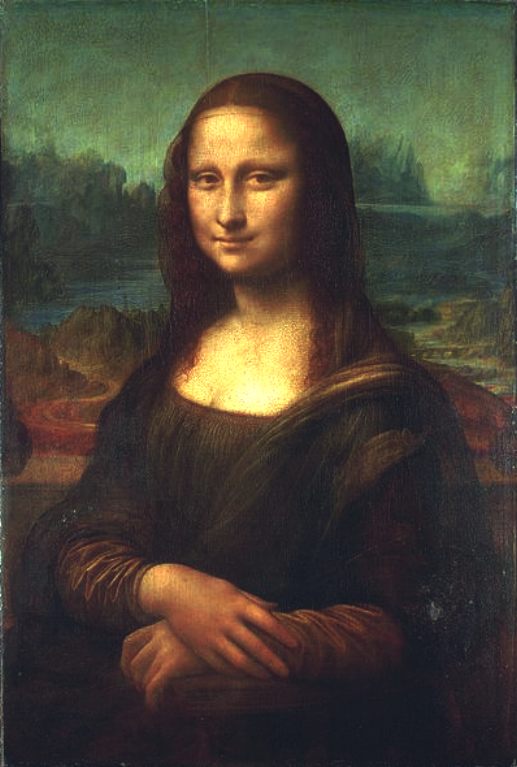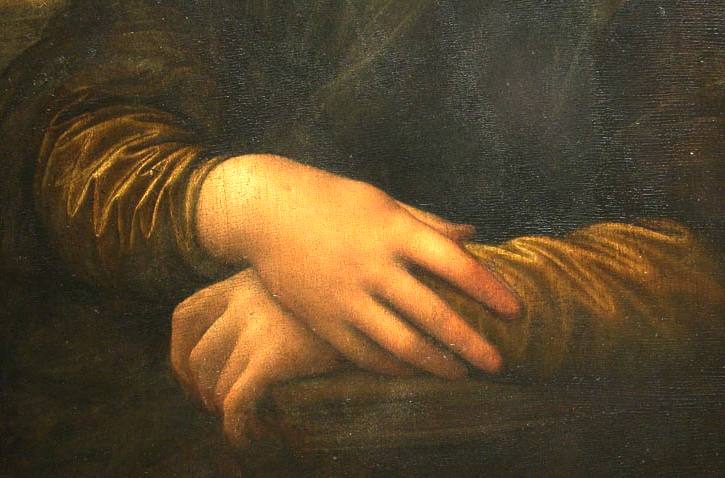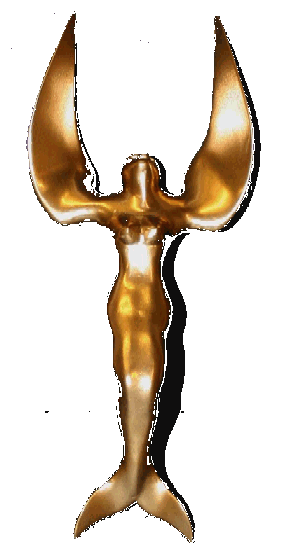|

The Mona Lisa (La Gioconda or La Joconde, or Portrait of Lisa Gherardini, wife of Francesco del Giocondo) is a half-length portrait of a woman by the Italian artist Leonardo da Vinci, which has been acclaimed as "the best known, the most visited, the most written about, the most sung about, the most parodied work of art in the world."
The
painting measures 24" x 30". That is much larger than most
people realise. I attempted to paint this picture using first acrylics
to get a handle on the colour mixing, then oils. I managed to get the
colour shading quite accurate, but had some trouble with the getting the
face to look exactly the same. The hands were easier to duplicate. I got
fed up with the background, which is why I think Leonardo
failed to detail more. The representation above is not 100% for colours,
but, then, you'd have to work from the original to get it spot on and
even that is faded badly - so interpretation is yours to decide - and
that may explain why there are so many good copies about.
The painting, thought to be a portrait of Lisa Gherardini, the wife of Francesco del Giocondo, is in oil on a poplar panel, and is believed to have been painted between 1503 and 1506. It was acquired by King Francis I of France and is now the property of the French Republic, on permanent display at the Musée du Louvre in Paris. The ambiguity of the subject's expression, frequently described as enigmatic, the monumentality of the composition, the subtle modeling of forms and the atmospheric illusionism were novel qualities that have contributed to the continuing fascination and study of the work.
TITLE
The painting's title Mona Lisa stems from a description by Giorgio Vasari: "Leonardo undertook to paint, for Francesco del Giocondo, the portrait of Mona Lisa, his wife...." In Italian, ma donna means my lady. This became madonna, and its contraction mona. Mona was thus a polite form of address, similar to Ma’am, Madam, or my lady in English. Though traditionally spelled "Mona" (as used by Vasari), in modern Italian, this short form of madonna is now usually spelled Monna. The title is therefore sometimes given as Monna Lisa, but this is rare in
English. "Monna Lisa" is the normal spelling in modern Italian.
Vasari's account of the Mona Lisa comes from his biography of Leonardo published in 1550, 31 years after the artist's death, and which has long been the best known source of information on the provenance of the work and identity of the sitter. That Leonardo painted such a work, and its date, were confirmed in 2005 when a scholar at Heidelberg University discovered a margin note in a volume of Cicero printed in 1477. It had been written by Leonardo's contemporary Agostino Vespucci and likened Leonardo to Apelles, who is mentioned in the text. The margin note states that Leonardo was at that time working on a painting of Lisa del Giocondo and is dated October 1503. At his death in 1525, Leonardo's assistant Salai owned a portrait named in his personal papers as la Gioconda which had been bequeathed to him by the artist. Italian for "jocund", "happy" or "jovial", La Gioconda ("the jocund one") was a pun on the feminine form of the sitter's married name Giocondo. In French, the title La Joconde has the same meaning.
The sitter, Lisa del Giocondo, was a member of the Gherardini family of Florence and Tuscany and the wife of wealthy Florentine silk merchant Francesco del Giocondo.[ The painting is thought to have been commissioned for their new home and to celebrate the birth of their second son, Andrea.
Over the years there have been several alternative views. Some scholars have argued that Lisa del Giocondo was the subject of a different portrait, identifying at least four other paintings as the Mona Lisa referred to by Vasari. Several other individuals have been proposed as the subject of the painting including Isabella of Naples, Cecilia Gallerani, Costanza d'Avalos, Duchess of Francavilla, Isabella d'Este, Pacifica Brandano or Brandino, Isabela Gualanda, Caterina Sforza, and Leonardo himself. Today the consensus of art historians is that the painting depicts Lisa del Giocondo, which has always been the traditional view.

HISTORY
Leonardo da Vinci began painting the Mona Lisa in 1503 or 1504 in Florence, Italy. According to Leonardo's contemporary, Giorgio Vasari, "...after he had lingered over it four years, left it unfinished...." Leonardo, later in his life, is said to have regretted "never having completed a single work".
In 1516 Leonardo was invited by King François I to work at the Clos Lucé near the king's castle in Amboise. It is believed that he took the Mona Lisa with him and continued to work after he moved to
France. On his death the painting was inherited, among other works, by his pupil and assistant Salaì. The king bought the painting for 4,000 écus and kept it at Palace of Fontainebleau, where it remained until given to Louis XIV. Louis XIV moved the painting to the Palace of Versailles. After the French Revolution, it was moved to the Louvre, but spent a brief period in the bedroom of Napoleon in the Tuileries Palace.
During the Franco-Prussian War (1870–1871) it was moved from the Louvre to the Brest Arsenal. During World War II, the painting was again removed from the Louvre and taken safely, first to Château d'Amboise, then to the Loc-Dieu Abbey and Château de Chambord, then finally to the Ingres Museum in Montauban.
Theft and vandalism
The painting's fame was emphasized when it was stolen on 21 August 1911. The next day, Louis Béroud, a painter, walked into the Louvre and went to the Salon Carré where the Mona Lisa had been on display for five years. However, where the Mona Lisa should have stood, he found four iron pegs. Béroud contacted the section head of the guards, who thought the painting was being photographed for marketing purposes. A few hours later, Béroud checked back with the section head of the museum, and it was confirmed that the Mona Lisa was not with the photographers. The Louvre was closed for an entire week to aid in investigation of the theft.
French poet Guillaume Apollinaire, who had once called for the Louvre to be "burnt down," came under suspicion; he was arrested and put in jail. Apollinaire tried to implicate his friend Pablo Picasso, who was also brought in for questioning, but both were later exonerated.
At the time, the painting was believed to be lost forever, and it was two years before the real thief was discovered. Louvre employee Vincenzo Peruggia had stolen it by entering the building during regular hours, hiding in a broom closet and walking out with it hidden under his coat after the museum had closed. Peruggia was an Italian patriot who believed Leonardo's painting should be returned to Italy for display in an Italian museum. Peruggia may have also been motivated by a friend whose copies of the original would significantly rise in value after the painting's theft. After having kept the Mona Lisa in his apartment for two years, Peruggia grew impatient and was finally caught when he attempted to sell it to the directors of the Uffizi Gallery in Florence; it was exhibited all over Italy and returned to the Louvre in 1913. Peruggia was hailed for his patriotism in Italy and served six months in jail for the crime.
During World War
II, the painting was again removed from the Louvre and taken safely, first to Château d'Amboise, then to the Loc-Dieu Abbey and Château de Chambord, then finally to the Ingres Museum in Montauban. In 1956, the lower part of the painting was severely damaged when a vandal doused the painting with acid. On 30 December of that same year, a young Bolivian named Ugo Ungaza Villegas damaged the painting by throwing a rock at it. This resulted in the loss of a speck of pigment near the left elbow, which was later painted over.
The use of bulletproof glass has shielded the Mona Lisa from more recent attacks. In April 1974 a "lame woman", upset by the museum's policy for disabled people, sprayed red paint at the painting while it was on display at the Tokyo National Museum. On 2 August 2009, a Russian woman, distraught over being denied French citizenship, threw a terra cotta mug or teacup, purchased at the museum, at the painting in the Louvre; the vessel shattered against the glass enclosure. In both cases, the painting was undamaged.
Aesthetics
Leonardo used a pyramid design to place the woman simply and calmly in the space of the painting. Her folded hands form the front corner of the pyramid. Her breast, neck and face glow in the same light that models her hands. The light gives the variety of living surfaces an underlying geometry of spheres and circles. Leonardo referred to a seemingly simple formula for seated female figure: the images of seated Madonna, which were widespread at the time. He effectively modified this formula in order to create the visual impression of distance between the sitter and the observer. The armrest of the chair functions as a dividing element between Mona Lisa and the viewer.
The woman sits markedly upright with her arms folded, which is also a sign of her reserved posture. Only her gaze is fixed on the observer and seems to welcome him to this silent communication. Since the brightly lit face is practically framed with various much darker elements (hair, veil, shadows), the observer's attraction to it is brought to even greater extent. The woman appears alive to an unusual measure, which Leonardo achieved by his new method not to draw the outlines, "mainly in two features: the corners of the mouth, and the corners of the eyes" (Gombrich), as firmly as that had been the use, before (sfumato). There is no indication of an intimate dialogue between the woman and the observer as is the case in the Portrait of Baldassare Castiglione (Louvre) painted by Raphael about ten years later, and undoubtedly influenced by the work.
The painting was among the first portraits to depict the sitter before an imaginary landscape and Leonardo was one of the first painters to use aerial perspective. The enigmatic woman is portrayed seated in what appears to be an open loggia with dark pillar bases on either side. Behind her a vast landscape recedes to icy mountains. Winding paths and a distant bridge give only the slightest indications of human presence. The sensuous curves of the woman's hair and clothing are echoed in the undulating imaginary valleys and rivers behind her. The blurred outlines, graceful figure, dramatic contrasts of light and dark, and overall feeling of calm are characteristic of Leonardo's style. Owing to the expressive synthesis that Leonardo achieved between sitter and landscape it is arguable whether Mona Lisa should be considered as a traditional portrait, for it represents an ideal rather than a real woman. The sense of overall harmony achieved in the painting—especially apparent in the sitter's faint smile—reflects the idea of a link connecting humanity and nature.
Mona Lisa has no clearly visible eyebrows or eyelashes. Some researchers claim that it was common at this time for genteel women to pluck these hairs, as they were considered unsightly. In 2007, French engineer Pascal Cotte announced that his ultra high resolution scans of the painting provide evidence that Mona Lisa was originally painted with eyelashes and with better visible eyebrows, but that these had gradually disappeared over time, perhaps as a result of
over-cleaning. For modern viewers the nearly missing eyebrows add to the slightly abstract quality of the face.
There has been much speculation regarding the painting's model and landscape. For example, that Leonardo probably painted his model faithfully since her beauty is not seen as being among the best, "even when measured by late quattrocento (15th century) or even twenty-first century standards." Some art historians in Eastern art, such as Yukio Yashiro, also argue that the landscape in the background of the picture was influenced by Chinese paintings; however, this thesis has been contested for lack of clear evidence.
Conservation
The Mona Lisa has survived for more than 500 years, and an international commission convened in 1952 noted that "the picture is in a remarkable state of preservation." This is partly due to the result of a variety of conservation treatments the painting has undergone. A detailed analysis in 1933 by Madame de Gironde revealed that earlier restorers had "acted with a great deal of restraint." Nevertheless, applications of varnish made to the painting had darkened even by the end of the 16th century, and an aggressive 1809 cleaning and revarnishing removed some of the uppermost portion of the paint layer, resulting in a washed-out appearance to the face of the figure. Despite the treatments, the Mona Lisa has been well cared for throughout its history, and although the panel's warping caused the curators "some worry", the 2004–05 conservation team was optimistic about the future of the work.
Poplar panel
At some point in its history, the Mona Lisa was removed from its original frame. The unconstrained poplar panel warped freely with changes in humidity, and as a result, a crack developed near the top of the panel, extending down to the hairline of the figure. In the mid-18th century to early 19th century, two butterfly-shaped walnut braces were inserted into the back of the panel to a depth of about 1/3 the thickness of the panel. This intervention was skillfully executed, and successfully stabilized the crack. Sometime between 1888 and 1905, or perhaps during the picture's theft, the upper brace fell out. A later restorer glued and lined the resulting socket and crack with cloth. The flexible oak frame (added 1951) and cross braces (1970) help to keep the panel from warping further.
The picture is currently kept under strict, climate-controlled conditions in its bulletproof glass case. The humidity is maintained at 50% ±10%, and the temperature is maintained between 18 and 21 °C. To compensate for fluctuations in relative humidity, the case is supplemented with a bed of silica gel treated to provide 55% relative humidity.
Frame
Because the Mona Lisa's poplar support expands and contracts with changes in humidity, the picture has experienced some warping. In response to warping and swelling experienced during its storage during World War II, and to prepare the picture for an exhibit to honor the anniversary of Leonardo's 500th birthday, the Mona Lisa was fitted in 1951 with a flexible oak frame with beech crosspieces. This flexible frame, which is used in addition to the decorative frame described below, exerts pressure on the panel to keep it from warping further. In 1970, the beech crosspieces were switched to maple after it was found that the beechwood had been infested with insects. In 2004–2005, a conservation and study team replaced the maple crosspieces with sycamore ones, and an additional metal crosspiece was added for scientific measurement of the panel's warp.
The Mona Lisa has had many different decorative frames in its history, owing to changes in taste over the centuries. In 1909, the Comtesse de Béhague gave the portrait its current frame, a Renaissance-era work consistent with the historical period of the Mona Lisa. The edges of the painting have been trimmed at least once in its history to fit the picture into various frames, but no part of the original paint layer has been trimmed.
Cleaning and touch-up
The first and most extensive recorded cleaning, revarnishing, and touch-up of the Mona Lisa was an 1809 wash and revarnishing undertaken by Jean-Marie Hooghstoel, who was responsible for restoration of paintings for the galleries of the Musée Napoléon. The work involved cleaning with spirits, touch-up of colour, and revarnishing the painting. In 1906, Louvre restorer Eugène Denizard performed watercolour retouches on areas of the paint layer disturbed by the crack in the panel. Denizard also retouched the edges of the picture with varnish, to mask areas that had been covered initially by an older frame. In 1913, when the painting was recovered after its theft, Denizard was again called upon to work on the Mona Lisa. Denizard was directed to clean the picture without solvent, and to lightly touch up several scratches to the painting with watercolour. In 1952, the varnish layer over the background in the painting was evened out. After the second 1956 attack, restorer Jean-Gabriel Goulinat was directed to touch up the damage to Mona Lisa's left elbow with watercolour.
In 1977, a new insect infestation was discovered in the back of the panel as a result of crosspieces installed to keep the painting from warping. This was treated on the spot with carbon tetrachloride, and later with an ethylene oxide treatment. In 1985, the spot was again treated with carbon tetrachloride as a preventive measure.
Display
On 6 April 2005—following a period of curatorial maintenance, recording, and analysis—the painting was moved to a new location within the museum's Salle des États. It is displayed in a purpose-built, climate-controlled enclosure behind bulletproof glass. The renovation of the gallery where the painting now resides was financed by the Japanese broadcaster Nippon Television. About 6 million people view the painting at the Louvre each year. A charcoal and graphite study of the Mona Lisa attributed to Leonardo is in The Hyde Collection, in Glens Falls, New York.
Fame
Historian Donald Sassoon catalogued the growth of the painting's fame. During the mid-19th century, Théophile Gautier and the Romantic poets were able to write about Mona Lisa as a femme fatale because Lisa was an ordinary person. Mona Lisa "...was an open text into which one could read what one wanted; probably because she was not a religious image; and, probably, because the literary gazers were mainly men who subjected her to an endless stream of male fantasies." During the 20th century, the painting was stolen, an object for mass reproduction, merchandising, lampooning and speculation, and was reproduced in "300 paintings and 2,000 advertisements". The subject was described as deaf, in mourning, toothless, a "highly-paid tart", various people's lover, a reflection of the artist's neuroses, and a victim of syphilis, infection, paralysis, palsy, cholesterol or a toothache. Scholarly as well as amateur speculation assigned Lisa's name to at least four different paintings and the sitter's identity to at least ten different people.
Visitors generally spend about 15 seconds viewing the Mona Lisa. Until the 20th century, Mona Lisa was one among many and certainly not the "most famous painting" in the world as it is termed today. Among works in the Louvre, in 1852 its market value was 90,000 francs compared to works by Raphael valued at up to 600,000 francs. In 1878, the Baedeker guide called it "the most celebrated work of Leonardo in the Louvre". Between 1851 and 1880, artists who visited the Louvre copied Mona Lisa roughly half as many times as certain works by Bartolomé Esteban Murillo, Antonio da Correggio, Paolo Veronese, Titian, Jean-Baptiste Greuze and Pierre-Paul Prud'hon.
From December 1962 to March 1963, the French government lent it to the United States to be displayed in New York City and Washington, D.C. In 1974, the painting was exhibited in Tokyo and Moscow.
Before the 1962–1963 tour, the painting was assessed, for insurance purposes, as valued at $100 million; the insurance was not bought. Instead more money was spent on security. As an expensive painting, it has only recently been surpassed, in terms of actual price, by four other paintings: the Portrait of Adele Bloch-Bauer I by Gustav Klimt, which was sold for $135 million, the Woman III by Willem de Kooning sold for $138 million in November 2006, and No. 5, 1948 by Jackson Pollock sold for $140 million in November 2006 and one painting from The Card Players series by Paul Cezanne sold for a record of more than $250million. Although these figures are greater than the 1962 figure at which the Mona Lisa was valued, the comparison does not account for the change in prices due to inflation – $100 million in 1962 is approximately $720 million in 2010 when adjusted for inflation using the US Consumer Price Index.
Speculation
Although the sitter has traditionally been identified as Lisa del Giocondo, a lack of definitive evidence has long fueled alternative theories, including Leonardo's mother Caterina in a distant memory and the possibility that Leonardo used his own likeness. Other aspects of the painting that have been subject to speculation are the original size of the painting, whether it is the original, why it was painted, and various explanations for how the effect of an enigmatic smile was achieved.
Legacy
The avant-garde art world has made note of the undeniable fact of the Mona Lisa's popularity. Because of the painting's overwhelming stature, Dadaists and Surrealists often produce modifications and caricatures. Already in 1883, Le rire, an image of a Mona Lisa smoking a pipe, by Sapeck (Eugène Bataille), was shown at the "Incoherents" show in Paris. In 1919, Marcel Duchamp, one of the most influential modern artists, created L.H.O.O.Q., a Mona Lisa parody made by adorning a cheap reproduction with a moustache and a goatee. Duchamp added an inscription, which when read out loud in French sounds like "Elle a chaud au cul" literally translated: "she has a hot ass", implying the woman in the painting is in a state of sexual excitement and intended as a Freudian joke. According to Rhonda R. Shearer, the apparent reproduction is in fact a copy partly modelled on Duchamp's own face.
Salvador Dalí, famous for his surrealist work, painted Self portrait as Mona Lisa in 1954. In 1963 following the painting's visit to the United States, Andy Warhol created serigraph prints of multiple Mona Lisas called Thirty are Better than One, like his works of Marilyn Monroe (Twenty-five Coloured Marilyns, 1962), Elvis Presley (1964) and Campbell's soup (1961–1962).

MONALISA
MARINE NAVIGATION SYSTEM
MonaLisa is a
'Motorways of the Sea' project which aims to make a contribution to efficient, safe and environmentally friendly maritime
transport of the future. This is done through development, demonstration and dissemination of innovative e-navigational services to the shipping industry, which can lay the groundwork for a future international deployment.
A concept paper of Dynamic & Proactive Route planning was completed
by November 2011.
The project is sufficiently advanced that focus has now been transferred from development of
the concept (design and system development) to testing and validating of the concept.
The first simulated transmission between ship and shore with route-updating procedure
was performed successfully in early January 2012. Draft operational procedure plans
have been drawn up.
The first tests of the concept on board the Swedish working vessel Fyrbyggaren
are to be carried out at the end of 2012. The first tests onboard commercial vessels are
set to start in Spring 2013.
A study is now underway as to how to integrate port information in the MONALISA concept. This
is a critical issue.
Comprehensive studies on the regulatory framework, especially IMO regulations and UNCLOS, as well as a socio-economic analysis, are ongoing.
A
legal and socio-economic studies will be presented in 2013.
Cooperation has been established with the WWF (World Wildlife Foundation)
maritime division. The WWF has commissioned a study of the environmental
impact of dynamic & proactive route planning.
The test bed of MONALISA is to cover the Mediterranean (Baltic) Sea. The
competing SolarNavigator
project is a world autonomous
circumnavigation.
The basic concept on Global Sharing of Maritime Information was presented at the IALA workshop in September
2011, to be expanded in 2013.
MONA LISA 2
MonaLisa 2 is a new project initiative on Sea Traffic Management with
increased focus on the safe navigation of large passenger vessels; after
the Costa
Concordia and Baltic
Ace accidents in January and December 2012.
Activity 1 – Extended test-bed for Dynamic & Proactive Routeplanning
Extended test-bed for MONALISA Dynamic and Proactive Routeplanning (Sea Traffic Management).
The activity encompasses both deployment and operation tests of a Sea Traffic Control Centre (STCC)
in cooperation with shipping companies.
Activity 2 – Information management; a study on development of the SESAR concept for the Maritime Sector (LEONARDO).
The Leonardo concept implemented in the maritime sector is the paradigm shift of information management by introduction of
'Voyage based operations' instead of 'Surface based operations', as is the practice in the maritime world of today. With a combination of the SWIM Process (System Wide Information Management) and Voyage based operations, the maritime sector is anticipated to solve the obstacles to obtain a complete chain of
information.
Activity 3 – Human Factors: Certificates, Routeplanning, Bridge procedures, responsibilities and education
Activity 4 - Safer Ships & SAR
Activity 5 – Large Passenger Ships in Ports, aims at improving the ability of
port authorities to handle risks connected with these large vessels.
Time schedule - MONALISA 2.0 is estimated to be implemented between 2012-2014.
PARTNERSHIPS MONALISA 1

The
Danish
Maritime Authority has responsibility for the
construction, equipment and operation of Danish ships including safety, navigational
regulations, ship registration, shipping policy, maritime law as well as industrial policy, both nationally and
internationally. The DMA is a government agency
part of the Ministry of Business.

The
Finnish Transport
Agency The Finnish Transport Agency is responsible for the traffic management on roads, waterways and railways.
The Finnish Transport Agency’s Hydrographic Office publishes printed and electronic charts of Finland’s coastal and lake areas and manages the ongoing chart update service.

GateHouse is
specialises in the development of technical software and system integration for advanced satellite communications and tracking systems.
They are a leading independent provider of complete embedded software for Inmarsat BGAN terminals

SAAB serves the global market:
governments (navy), coastguards and corporations with products, services and solutions
from military defence to civil navigation via LPI pulsed radar, sonar
and other transponders.

SSPA provide effective marine transport solutions for the maritime field – ship design, maritime operations, port development
and coastal services. Seventy percent of the earth’s surface is water,
with 90 percent of cargo transported by ships. SSPA is aware that the maritime industry
has tremendous impact on our environment.

The Swedish
Maritime Administration (SMA) offers modern and safe shipping routes with 24 hour service.
SMA is a governmental agency and enterprise within the transport sector and is responsible for maritime safety
and the future of shipping, primarily merchant shipping, but also pleasure boating and fishing.
Services include: Pilotage and Maritime Traffic Information

The University
of Chalmers is a highly progressive, situated in Gothenburg, Sweden.
They are knonw globally for education, research and innovation.

EfficienSea
is concerned with the development of safe sustainable traffic at sea -
in particular the e-Navigation:
"the harmonized creation, collection, integration, exchange and presentation of maritime information on board and ashore by electronic means to enhance berth-to-berth navigation and related services, for safety and security at sea and protection of the marine
environment." Ref: Committee of the International Association of Marine Aids to Navigation and Lighthouse Authorities,
IALA.
Modern technology on the vessel bridge provides a lot of information that is supposed to help the navigator. But part of the information is unorganized and the excess of information can lead to accidents.
E-Navigation a new standard for organizing the information, providing for better means of
navigation. One system integrates all the necessary information to give the right information at the right time, filtering out everything that is irrelevant for safe navigation.

PARTNERSHIPS
MONALISA 2.0 - is/are under development. Maritime authorities, private sector partners as well as academic organizations are invited to join the project.
DESCRIPTION OF GLOBAL PROJECT
The main objective of the global project is to contribute to the promotion of the Motorways of the
Sea (MoS) concept in line with, the EU's Strategy for the Baltic Sea Region.
The global project will also contribute to develop and implement the EU´s e-maritime initiative.
Activity 1 - Dynamic & Proactive Route planning (DPR)
Activity one aims to develop and test a new model in route planning based on existing Electronic
Nautical Charts and Automatic Identification. Each vessel's pre-planned route will be
visible for other vessels and monitoring centres ashore. Radio communications between vessels will not be needed when preplanned routes clearly describe all navigators intended routes on screens onboard. Monitoring
centres and others will immediately see if a vessel is deviating from a pre-planned route and will be
able to take action. All vessel routes will be available for other ships for
anti-collision
purposes.
Activity 4 - Global Sharing of Maritime Information (GSMI) - The main goal of this activity is to enable sharing
maritime data on a global scale based on the experience gained from HELCOM AIS, SafetSeaNet and Stires
systems.
Activity four will be implemented within ten sub-activities:
1. Preparation and process planning
Analyses of relevant findings and experience from other projects and transport modes. A detailed
description of the concept/methodology will be elaborated. This subactivity is to be completed in
November 2011 and delivered as a report. The report will be reviewed by external experts.
2. Routes
Elaboration of optimal routes for the vessels is a demanding task of the Activity. Required
transmission data will be assessed and suitable protocols and operative schedule including
interfaces will be determined. User requirements and technical requirements for onboard and
control centres will be prepared. Standards for different ship models and fairway details will be
elaborated together with criteria for calculation of best route and speed pattern for each individual
ship. Possible conflict processes will be assessed. Required capacity for hardware and software
onboard and ashore will be prepared. The specification to be used in software development is to be
delivered end of August 2011. Basic algorithms for construction of routes and voyage plans will be
elaborated, based on different relevant indata. The first tests of communication voyage plans will be
performed in simulators at Chalmers in November 2011. Iterative tests will continue during 2012.
3. Technical solutions
The best possible transmission systems will be tested and evaluated. Possibilities to obtain data
from established meteorological institutions will be investigated. Hydrographical information will
be gathered. Technical solution for presentation of other vessels routes onboard ships will be worked out. Introduction of new display to be used
onboard vessels is to be delivered in December 2011. A definition of transmission systems will be presented by the
end of April 2012. A Ship toship solution for transmission of routes between vessels is to be delivered in the end of May 2012.
4. Surveillance and security
Technique and process for detection of anomalities within route legs will be elaborated together
with assessment of security issues connected to system information. A first beta model will be
delivered in July 2012. Complete system is to be delivered in January 2013. Security systems is to
be delivered in July 2012.
5. Ports
Required information from different kind of ports for optimization of vessels voyages will be
assessed. Models for input data will be established in December 2012. First port (Gothenburg
engaged December 2012, followed by a second port (Aarhus) in January 2012 and a third port
(Stockholm) in April 2012.
6. Legal matters
Possible legal obstacles and liabilities in international legislation will be assessed together with
proposals for adjustments. Complete report delivered in June 2012, covering
liabilities and comparison with air traffic regulations and related legislation for the civil aviation.
7. Formal Safety Assessment
An analysis will be carried out to assess how the risk factor regarding safety is changed with
implementation of the system. A report with a Formal Safety Assessment is to be delivered end of
January 2013
8. Human factors
Man-technology-organisation studies will be performed. Officer’s opinion on the system functions
will be investigated. Workshops with end-users to be continuously performed. A report will be
submitted by the end of June 2013
9. Test and evaluation
Simulations of the operating system will be performed in a simulator. Sound VTS center and some
vessels will be utilized for a full scale test. First operational tests will be carried out in simulators at
Chalmers before the end of May 2012. First full scale tests onboard vessels will be carried out
during year 2013 and should be finalised before the end of October 2013.
10. Dissemination
A website for the activity will be created and an information movie about proactive route planning
produced. A project website will be up and running end of February 2011. At least 20 relevant
conferences, workshops or symposiums will be attended during the full project time, were the
MONALISA project will be presented. Website calendar will continuously be
updated to include a movie presenting the dynamics.
MONA
LISA CONTACTS
Magnus
Sundström
MONALISA Project Leader
Swedish
Maritime Administration
Market Department
Phone: +46 10 47 84 681
E-mail: magnus.sundstrom@sjofartsverket.se
http://www.sjofartsverket.se/en/MonaLisa/
MONALISA
PARTNER'S LINKS
Danish
Maritime Authority
Finnish
Traffic Agency
Gatehouse
Saab
SSPA
Swedish
Maritime Administration
University
of Chalmers
EfficienSea
Swedish
Traffic Agency - Info about Green Corridors
An
initiative from the European Commission
The
Mona Lisa with Professor Donald Sassoon

The
ultimate Robot Boat. Solarnavigator uses an advanced SWASSH
hull as the platform
to
mount the world's first autonomous circumnavigation. A successful
expedition could pave the way for improved safety
at sea.

|











